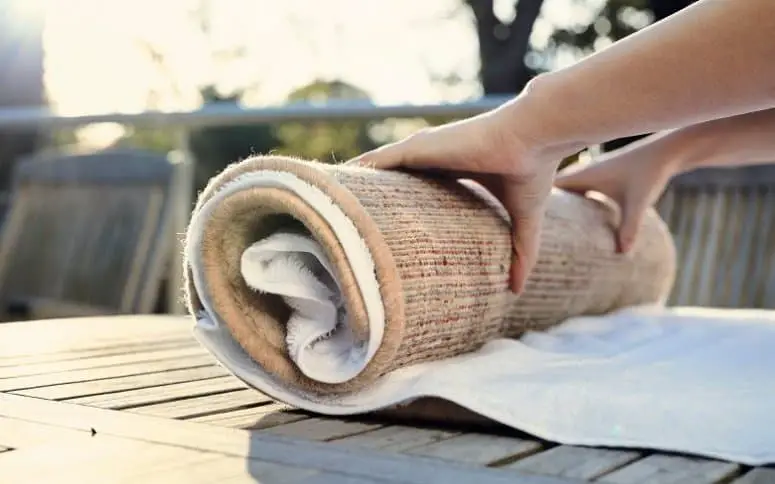Wool is a beautiful, luxurious fabric that requires finesse when cleaning. And while carpets and rugs often serve a similar purpose – covering your bare floor – you cannot clean them the same way. Here is an essential guide on how to clean wool carpeting and rugs.
Carpets
Vacuum Once A Week

There is a common misconception in the cleaning community that wool carpets do not need to be vacuumed as often as synthetic carpets. This claim is often backed by wool’s natural resilience to showing grit and dirt.
People that stand by this mentality often swear that there is such a thing as over-vacuuming wool: they think that if you vacuum more than once a month, you run the risk of damaging your carpet.
This is simply not true.
Wool carpets do not repel dust and dirt; on the contrary, wool captures them inside it’s air-pockets. Wool is like a sponge: it absorbs dirt, dust, and grime, but it cannot take in an infinite amount. Sooner or later, what went in must come out.
Read More:Best vacuum cleaners for Berber carpet in 2018
Just as a sponge will drip if it is over-bloated, your carpet will expel the excess filth that it has been harboring. And the scariest thing about this is that wall-to-wall wool carpets can hold 2 to 5 pounds of filth before it starts to show!
The best way to prevent this grit-explosion from occurring in your home is to vacuum the right way, once a week.
So what is the right way to vacuum wool carpets? Unlike synthetic carpets, wool carpets are more delicate; therefore, it is best to use an adjustable upright or canister vacuum.
While you should use a vacuum with strong suction power, be mindful of the vacuum’s beater bar. Beating your wool carpet with too much force can damage its fibers, so it is best to use a feather-like touch by adjusting the bar to the highest level, or if possible, shut it off completely.
Don’t Use High-Alkaline Cleaning Agents On Spills

Avoid using bleach, ammonia, or any chemical that does not have a neutral pH. These chemicals will harm your wool carpet.
When it comes to cleaning spills, simplicity is key: use a white cloth or paper towel to soak up the liquid while it is fresh. Next, apply a mixture of water, white vinegar, and dish soap to a clean white cloth, and blot (don’t rub!) the affected area until it is clear.
Have it Professionally Steam-Cleaned Annually—Don’t Do it Yourself!
Another common misconception is that carpet extraction devices are dangerous for wool carpets; however, remember that wool is hair, and all types of hair – fabric or otherwise – can be wet-cleaned, it just needs to be done properly.
Unless you are willing to buy a commercial-grade steam cleaner, don’t bother doing it yourself.
While brands like Bissell and Hoover offer rental machines, they are simply not suited for wool carpets. The problem is that these budget-friendly devices do not dry fast enough.
Wool is more susceptible to mold and mildew than it’s synthetic counterparts, so if you want to preserve the integrity of your wool carpet, you need to leave this to the professionals.
Rugs
Only Vacuum The Back Of The Rug

Wool rugs are more delicate than carpets because they are often interweaved with intricate designs. In fact, most vacuum cleaners are too abrasive: if applied directly to the top of the rug, a vacuum can easily break its docile weaves.
That is why it is best to vacuum (with the beater bar OFF if possible) the backside of the rug. The purpose here is to vibrate the rug so that all of the dormant packed soil and grit will loosen.
Then you can either shake or brush away everything that you forced to the rug’s top layer. If your rug is thick & sturdy – like a shag rug – then feel free to apply the vacuum to both sides. Before you vacuum a wool rug, consider its weight. When in doubt, stick to the back.
Go With the Grain, Not Against It
You should aim to dust your wool rugs as often as you vacuum your wool carpets – once a week. Your goal is to capture as much dust from the top layer before it works its way into the base.
When dusting, always go with the grain of the pile, not against it. While the rug’s design may confuse you, simply pet your rug with your hand to feel the pile’s natural direction. Use your vacuum’s upholstery tool or an electric sweeper to brush your rug.
Rotate Rugs Often

Rug bugs are real. And like humans, they become comfortable in environments that don’t change. Don’t let these pesky squatters stay rent-free. Rotate and shake your rugs often.
There is nothing more disturbing to a free-loading rug bug than exposing them to lots of fresh air and sunlight. Don’t call the sheriff; just give them a taste of the outside world.
I hope that you have found this guide on how to clean wool carpeting and rugs helpful. If you have any additional questions feel free to ask in the comment section!
Resources
Declutter your home once and for all (Even if you have no time and don't know where to begin)! Learn More.


